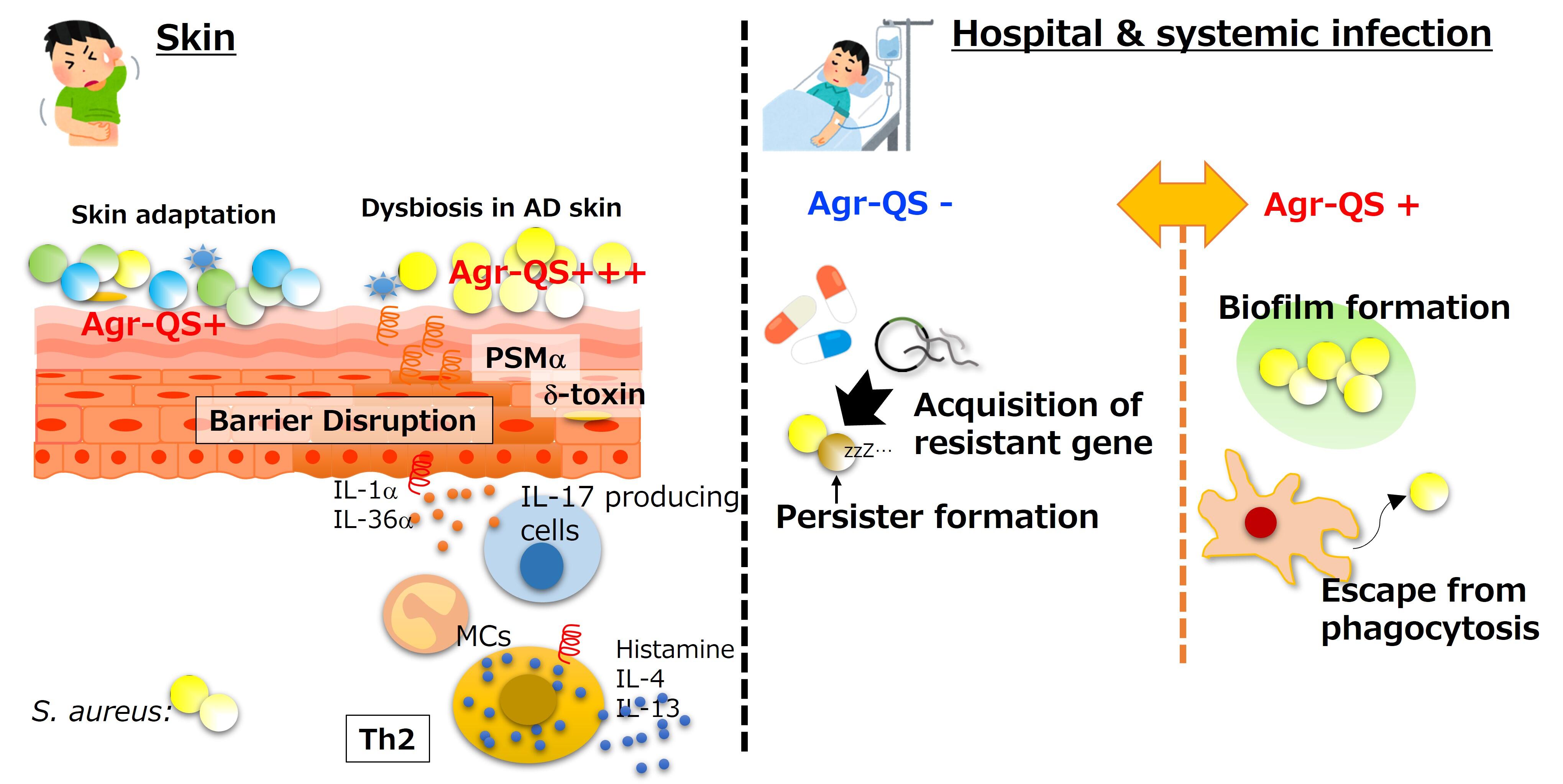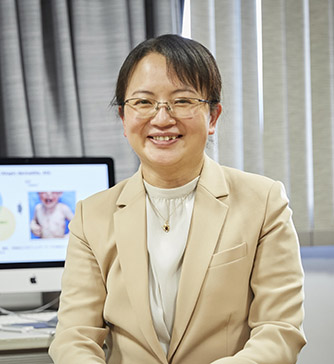Cutaneous Allergy and Host Defense
TEL +81-6-6879-4963
Overview
In chronic inflammatory diseases such as atopic dermatitis (AD), which are not classified as infectious diseases, it is important to determine whether the detection of a specific pathogen is simply a result of the disease, or whether it is involved in the pathology/cause of the disease. We previously found that accessory gene regulatory (Agr) quorum sensing (QS) in Staphylococcus aureus is essential for skin adaptation of this pathogenic bacteria and Agr-QS-associated toxins induce skin inflammation in AD. Since the onset of AD in infancy is involved in the subsequent development of food allergies, asthma, etc., known as the allergic march, one important research goal is to elucidate the mutual mechanism between host immunity and microorganisms in the presymptomatic infantile phase of AD. We are also interested in the role of bacterial QS in the hospital adaptation of S. aureus. This develops the diagnostic and therapeutic platforms of this hospital-adapted S. aureus and overcomes MRSA outbreaks.

Principal Investigator
Yumi Matsuoka Professor

Research field
Cutaneous Allergy and Host Defense
Education history
| 2003 | M.D., Yamanashi Medical University |
|---|---|
| 2009 | Ph.D., Chiba University Graduate School of Medicine |
| 2015 | Board Certified Dermatologist, The Japanese Dermatological Association |
Research and career history
| 2003 | Resident, Department of Dermatology, Yamanashi University Hospital (-2005) |
|---|---|
| 2005 | Clinical Fellow, Department of Dermatology, Yamanashi University Hospital (-2006) |
| 2006 | Clinical Fellow, Department of Dermatology, Chiba University Hospital (-2009) |
| 2009 | Postdoctoral Fellow, Department of Pathology, University of Michigan Medical School, USA. Mentor: Gabriel Nunez (-2013) |
| 2013 | Research Fellow, General Foundation Japan Preventive Medicine Association (-2014) |
| 2014 | Assistant Professor, Department of Dermatology, Chiba University Graduate School of Medicine (-2017) |
| 2018 | Lecturer, Department of Dermatology, Chiba University Graduate School of Medicine (-2019) |
| 2020 | Specially Appointed Associate professor, Osaka University Immunology Frontier Research Center (-2021) |
| 2022 | Associate professor, Osaka University Immunology Frontier Research Center |
| 2022- | Professor, Osaka University Immunology Frontier Research Center |
Members
-
Yumi Matsuoka Professor
ymatsuokaderma.med.osaka-u.ac.jp
Achievements
Publications
-
Nakamura Y, Kambe N, Saito M, Nishikomori R, Kim YG, Murakami M, Núñez G, Matsue H.; Mast cells mediate neutrophil recruitment and vascular leakage through the NLRP3 inflammasome in histamine-independent urticaria. J Exp Med. 2009 ; 206(5):1037-46.
-
Nakamura Y, Franchi L, Kambe N, Meng G, Strober W, Núñez G.; Critical role for mast cells in interleukin-1β-driven skin inflammation associated with an activating mutation in the nlrp3 protein. Immunity. 2012 ; 37(1):85-95.
-
Nakamura Y, Oscherwitz J, Cease KB, Chan SM, Muñoz-Planillo R, Hasegawa M, Villaruz AE, Cheung GY, McGavin MJ, Travers JB, Otto M, Inohara N, Núñez G. Staphylococcus δ-toxin induces allergic skin disease by activating mast cells. Nature. 2013 ; 503(7476):397-401.
-
Nakagawa S, Matsumoto M, Katayama Y, Oguma R, Wakabayashi S, Nygaard T, Saijo S, Inohara N, Otto M, Matsue H, Núñez G, Nakamura Y. Staphylococcus aureus Virulent PSMα Peptides Induce Keratinocyte Alarmin Release to Orchestrate IL-17-Dependent Skin Inflammation. Cell Host Microbe. 2017 ; 22(5):667-677.
-
Baldry M, Nakamura Y, Nakagawa S, Frees D, Matsue H, Núñez G, Ingmer H. Application of an agr-specific anti-virulence Compound as Therapy for Staphylococcus Aureus-induced Inflammatory Skin Disease. J Infect Dis. 2018 ; 218(6):1009-1013.
-
Miyachi H, Wakabayashi S, Sugihira T, Aoyama R, Saijo S, Koguchi-Yoshioka H, Fujimoto M, Núñez G, Matsue H, Nakamura Y. Keratinocyte IL-36 Receptor/MyD88 Signaling Mediates Malassezia-Induced IL-17-Dependent Skin Inflammation. J Infect Dis. 2021;223(10):1753-1765.
-
Nakamura Y, Takahashi H, Takaya A, Inoue Y, Katayama Y, Kusuya Y, Shoji T, Takada S, Nakagawa S, Oguma R, Saito N, Ozawa N, Nakano T, Yamaide F, Dissanayake E, Suzuki S, Villaruz A, Varadarajan S, Matsumoto M, Kobayashi T, Kono M, Sato Y, Akiyama M, Otto M, Matsue H, Núñez G, Shimojo N. Staphylococcus Agr virulence is critical for epidermal colonization and associates with atopic dermatitis development. Sci Transl Med. 2020 ; 12(551): eaay4068. doi: 10.1126/scitranslmed.aay4068.
-
Matsumoto M, Nakagawa S, Zhang L, Nakamura Y, Villaruz AE, Otto M, Wolz C, Inohara N, Núñez G. Interaction between Staphylococcus Agr virulence and neutrophils regulates pathogen expansion in the skin. Cell Host Microbe. 2021 ;29(6):930-940.
